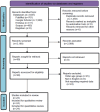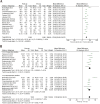Arthroscopic Procedure for Femoroacetabular Impingement Syndrome in Adolescents: A Systematic Review and Meta-analysis
- PMID: 40432174
- PMCID: PMC12120486
- DOI: 10.5371/hp.2025.37.2.87
Arthroscopic Procedure for Femoroacetabular Impingement Syndrome in Adolescents: A Systematic Review and Meta-analysis
Abstract
Femoroacetabular impingement (FAI) is caused by aberrant anatomy involving the proximal femur with or without the acetabulum resulting in mechanical impingement. FAI's effects can be devastating in the young. In recent studies, significant associations have been found between skeletal immaturity, FAI, and sports involvement. Hip arthroscopy for FAI has been demonstrated to produce good results. We opted to update the review and meta-analysis to further narrow the research gap in the literature by including recently published studies and a comprehensive review of the arthroscopic approach for FAI. Prior to January 1, 2024, PubMed, Embase, and Google Scholar databases were searched for the studies with data on surgical procedures and patient-related outcomes for arthroscopic FAI. RevMan 5.2 was utilized to calculate the pooled mean differences with a 95% confidence interval to compare reported postoperative and preoperative patients' outcomes. In total, 24 studies of adolescent subjects with a mean age of less than 20 years, including 1,619 patients and 1,767 hips, were included. Eleven studies included acetabuloplasty and femoroplasty as major treatments. When preoperative and postoperative outcomes were compared, statistically significant changes were seen in the mHHS (modified Harris hip score), HOS-ADL (Hip Outcome Score-Activities of Daily Living), HOS-SSS (Hip Outcome Score-Sports-Specific Subscale), i-HOT (International Hip Outcome Tool 12 questions), NAHS (Nonarthritic Hip Score), and the visual analog scale. Numbness, neuropraxia and infections were seen in only 12 patients. This meta-analysis demonstrated overall improvements in hip pain, quality of life, and hip function along with few complications.
Keywords: Adolescent; Femoroacetabular impingement; Hip arthroscopy; Meta-analysis.
Conflict of interest statement
No potential conflict of interest relevant to this article was reported.
Figures









Similar articles
-
Hip Arthroscopic Surgery for Femoroacetabular Impingement With Capsular Management: Factors Associated With Achieving Clinically Significant Outcomes.Am J Sports Med. 2018 Feb;46(2):288-296. doi: 10.1177/0363546517739824. Epub 2017 Nov 21. Am J Sports Med. 2018. PMID: 29161115
-
The Influence of Body Mass Index on Outcomes After Hip Arthroscopic Surgery With Capsular Plication for the Treatment of Femoroacetabular Impingement.Am J Sports Med. 2017 Aug;45(10):2303-2311. doi: 10.1177/0363546517705617. Epub 2017 May 18. Am J Sports Med. 2017. PMID: 28520460
-
Arthroscopic Management of Subspinous Impingement in Borderline Hip Dysplasia and Outcomes Compared With a Matched Cohort With Nondysplastic Femoroacetabular Impingement.Am J Sports Med. 2020 Oct;48(12):2919-2926. doi: 10.1177/0363546520951202. Epub 2020 Sep 8. Am J Sports Med. 2020. PMID: 32898429
-
Outcomes of Hip Arthroscopic Surgery in Adolescents With a Subanalysis on Return to Sport: A Systematic Review.Am J Sports Med. 2020 May;48(6):1526-1534. doi: 10.1177/0363546519875131. Epub 2019 Sep 20. Am J Sports Med. 2020. PMID: 31539278
-
Influence of Femoral Version on the Outcomes of Hip Arthroscopic Surgery for Femoroacetabular Impingement or Labral Tears: A Systematic Review and Meta-analysis.Orthop J Sports Med. 2021 Jun 10;9(6):23259671211009192. doi: 10.1177/23259671211009192. eCollection 2021 Jun. Orthop J Sports Med. 2021. PMID: 34179203 Free PMC article. Review.
References
-
- Sankar WN, Nevitt M, Parvizi J, Felson DT, Agricola R, Leunig M. Femoroacetabular impingement: defining the condition and its role in the pathophysiology of osteoarthritis. J Am Acad Orthop Surg. 2013;21 Suppl 1:S7–15. doi: 10.5435/JAAOS-21-07-S7. https://doi.org/10.5435/jaaos-21-07-s7. - DOI - PubMed
-
- Agricola R, Heijboer MP, Ginai AZ, et al. A cam deformity is gradually acquired during skeletal maturation in adolescent and young male soccer players: a prospective study with minimum 2-year follow-up. Am J Sports Med. 2014;42:798–806. doi: 10.1177/0363546514524364. https://doi.org/10.1177/0363546514524364. - DOI - PubMed
-
- Byrd JW, Jones KS, Gwathmey FW. Arthroscopic management of femoroacetabular impingement in adolescents. Arthroscopy. 2016;32:1800–6. doi: 10.1016/j.arthro.2016.02.019. https://doi.org/10.1016/j.arthro.2016.02.019. - DOI - PubMed
-
- Nwachukwu BU, Rebolledo BJ, McCormick F, Rosas S, Harris JD, Kelly BT. Arthroscopic versus open treatment of femoroacetabular impingement: a systematic review of medium- to long-term outcomes. Am J Sports Med. 2016;44:1062–8. doi: 10.1177/0363546515587719. https://doi.org/10.1177/0363546515587719. - DOI - PubMed
-
- Peters S, Laing A, Emerson C, et al. Surgical criteria for femoroacetabular impingement syndrome: a scoping review. Br J Sports Med. 2017;51:1605–10. doi: 10.1136/bjsports-2016-096936. https://doi.org/10.1136/bjsports-2016-096936. - DOI - PubMed
Publication types
LinkOut - more resources
Full Text Sources
Miscellaneous

